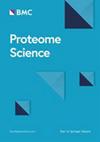蛋氨酸脑啡肽(MENK)通过下调 HMOX1 和铁蛋白保护巨噬细胞免于铁蛋白沉积症
IF 2.1
3区 生物学
Q3 BIOCHEMICAL RESEARCH METHODS
引用次数: 0
摘要
本研究旨在通过分析巨噬细胞RAW264.7的蛋白质谱和生物信息学来研究MENK的免疫学效应,并探讨巨噬细胞与铁突变之间的关系。我们采用蛋白质组学分析来鉴定巨噬细胞和受MENK干预的巨噬细胞之间的差异表达蛋白(DEPs)。共鉴定出 208 个 DEPs。其中,96个蛋白质表达上调,112个蛋白质表达下调。蛋白质组分析表明,与铁代谢相关的 DEPs 显著富集。利用 KEGG 通路图和蛋白质相互作用(PPI)分析鉴定了枢纽基因。本研究确定的枢纽基因包括 HMOX1 和铁蛋白(FTH 和 FTL)。在 GO 和 KEGG 数据库中,HMOX1、FTH 和 FTL 之间建立了相关性。PCR、WB和免疫荧光的结果表明,MENK下调了HMOX1和FTH的水平。MENK通过调节巨噬细胞的铁代谢,降低HMOX1和铁蛋白的水平,有可能成为一种辅助化疗药物。我们就MENK的治疗潜力提出了一个创新的研究方向,重点研究铁突变与巨噬细胞活性之间的关系。本文章由计算机程序翻译,如有差异,请以英文原文为准。
Methionine enkephalin (MENK) protected macrophages from ferroptosis by downregulating HMOX1 and ferritin
The aim of this work was to investigate the immunological effect of MENK by analyzing the protein spectrum and bioinformatics of macrophage RAW264.7, and to explore the relationship between macrophage and ferroptosis. We employed proteomic analysis to identify differentially expressed proteins (DEPs) between macrophages and macrophages intervened by MENK. A total of 208 DEPs were identified. Among these, 96 proteins had upregulated expression and 112 proteins had downregulated expression. Proteomic analysis revealed a significant enrichment of DEPs associated with iron metabolism. The identification of hub genes was conducted using KEGG pathway diagrams and protein-protein interaction (PPI) analysis. The hub genes identified in this study include HMOX1 and Ferritin (FTH and FTL). A correlation was established between HMOX1, FTH, and FTL in the GO and KEGG databases. The results of PCR, WB and immunofluorescence showed that MENK downregulated the level of HMOX1 and FTH. MENK had the potential to become an adjuvant chemotherapy drug by regulating iron metabolism in macrophages, reducing levels of HMOX1 and ferritin. We proposed an innovative research direction on the therapeutic potential of MENK, focusing on the relationship between ferroptosis and macrophage activity.
求助全文
通过发布文献求助,成功后即可免费获取论文全文。
去求助
来源期刊

Proteome Science
生物-生化研究方法
CiteScore
2.90
自引率
0.00%
发文量
17
审稿时长
4.5 months
期刊介绍:
Proteome Science is an open access journal publishing research in the area of systems studies. Proteome Science considers manuscripts based on all aspects of functional and structural proteomics, genomics, metabolomics, systems analysis and metabiome analysis. It encourages the submissions of studies that use large-scale or systems analysis of biomolecules in a cellular, organismal and/or environmental context.
Studies that describe novel biological or clinical insights as well as methods-focused studies that describe novel methods for the large-scale study of any and all biomolecules in cells and tissues, such as mass spectrometry, protein and nucleic acid microarrays, genomics, next-generation sequencing and computational algorithms and methods are all within the scope of Proteome Science, as are electron topography, structural methods, proteogenomics, chemical proteomics, stem cell proteomics, organelle proteomics, plant and microbial proteomics.
In spite of its name, Proteome Science considers all aspects of large-scale and systems studies because ultimately any mechanism that results in genomic and metabolomic changes will affect or be affected by the proteome. To reflect this intrinsic relationship of biological systems, Proteome Science will consider all such articles.
 求助内容:
求助内容: 应助结果提醒方式:
应助结果提醒方式:


